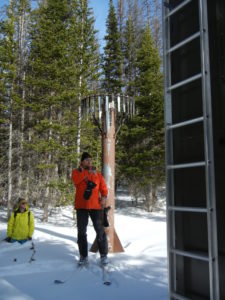
Researchers from CSU examine snowpack during snowmelt on Trail Ridge Road in Colorado. Photo: Steven Fassnacht/CSU
A new analysis of snowpack measurements led by researchers at Colorado State University has uncovered intriguing changes in snowfall and warming winter temperatures along the Rocky Mountains in the central portion of Colorado and southeastern Wyoming.
“The biggest thing we’ve seen here is that although winters are changing, they’re not changing the way we’ve seen in other locations across the western United States,” said Steven Fassnacht, professor in the Department of Ecosystem Science and Sustainability at CSU.
The study, “Sub-seasonal snowpack trends in the Rocky Mountain National Park area,” published in the journal Water, examined 35 years of data at 36 locations, including in Rocky Mountain National Park.
Using monthly data from manual and automated stations, the team — which also included scientists from the University of Göttingen in Germany and the University of Colorado — confirmed a finding that the temperatures along the Front Range of Colorado are getting warmer. But they also saw changes in snowfall on a monthly basis.
“We saw less snowfall in November and March; both those months are getting warmer as well,” said Fassnacht. In December and January, the team found a slight increase in snowfall, followed by an even bigger increase in snowfall, with colder temperatures, in February.
Finer resolution, smaller domain
Total winter precipitation and snowfall is not really changing in the sites that were studied in and around Rocky Mountain National Park, he added.
“We’ve seen a lot of studies that have really highlighted the decreases in the amount of snow that’s in the mountains across the western United States, but we looked at a finer resolution to better understand what is happening over this smaller domain, rather than using a shotgun approach,” Fassnacht said.

Traditionally, researchers have used measurements on April 1 as an indicator for the amount of water that is in the mountains. That works in some places, and in some years. But along the northern Front Range, many areas are still accumulating snow after April 1.
“In a good year, we may not hit peak until June 1,” Fassnacht explained. “Looking at these April 1 trends is not getting us the same information as we’re seeing over the whole winter. That can add a lot of moisture.”
Impact on tourism industry
The finding of warming temperatures could have an impact on the tourism industry in Colorado, where people plan winter activities based on reports of snowfall, or the lack thereof. In the 2017-18 season, the Rocky Mountain region’s ski resorts saw about 1 million fewer visits than the prior winter season. The region encompasses six states: Colorado, Idaho, New Mexico, Utah and Wyoming.
“Spring skiing and activities like snowmobiling decline in warmer weather,” said Fassnacht. As recently as 15 years ago, Arapahoe Basin or Loveland ski areas would be open well into June or July. Earlier this year, A-Basin closed June 3 while Loveland closed May 6.
“Except for the diehards, no seasoned snowboarder or skier wants to go to ski areas in June,” he said.
Study authors noted that few of the trends they found were statistically significant, creating “a tough issue,” said Fassnacht.
“Do we disregard findings if they’re not statistically significant? But what if everything is pointing in the same direction?” he said.
Daily analysis next
The research team continues to analyze the data, and are drilling down to look at daily snowpack measurements.
Fassnacht and co-author Daniel McGrath, assistant professor of geophysics at CSU, are also examining how these patterns of snowpack changes can be used to understand the persistence of very small glaciers along Colorado’s Front Range.
Co-authors of this study include Niah Venable, a research scientist with the Natural Resource Ecology Laboratory at CSU, and Glenn Patterson, an instructor in CSU’s Department of Ecosystem Science and Sustainability and the Colorado School of Public Health.